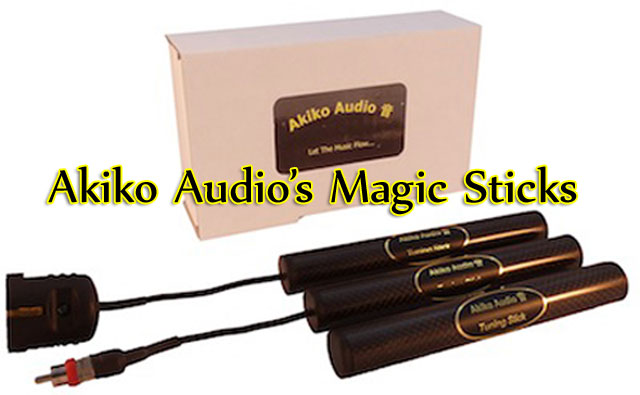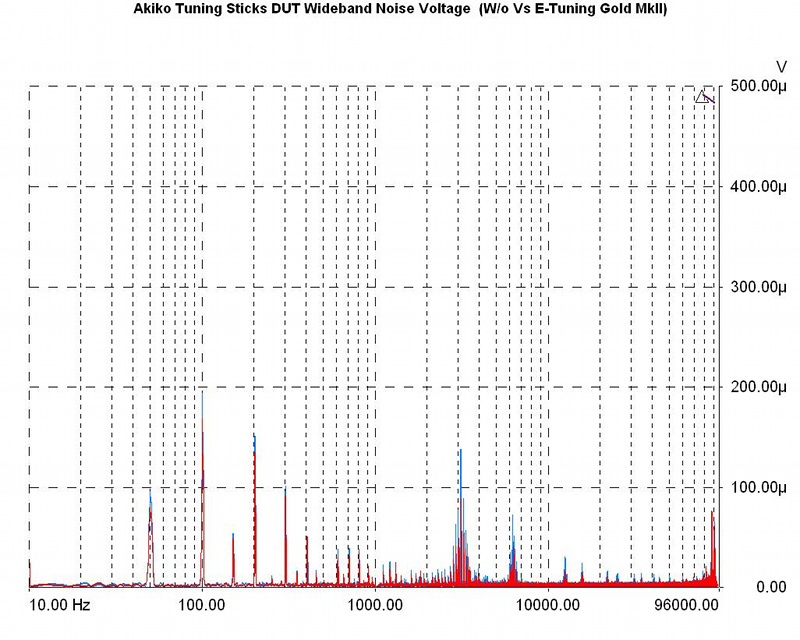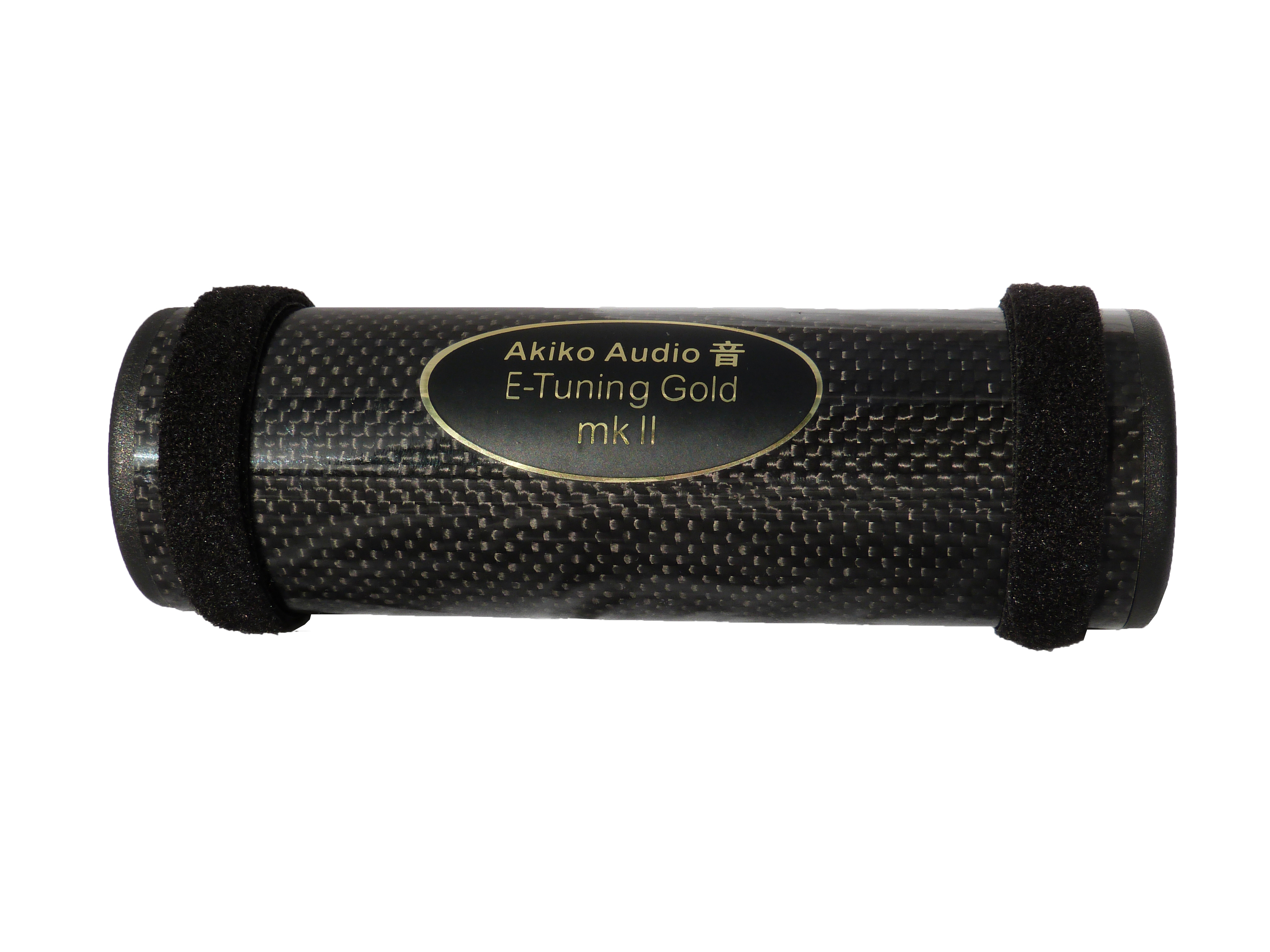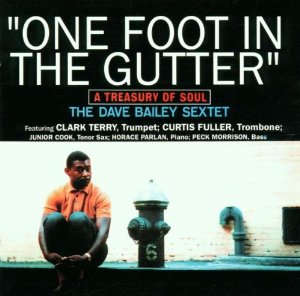Akiko Audio Tuning Devices



Akiko Audio was founded in the Netherlands in 2011 by Marc van Berlo and his son Sander. Since opening its doors, Akiko has grown steadily but I first heard of them through emails from a customer who seemed genuinely excited about their Tuning Sticks. After checking out this product on their website and learning that, like Acoustic Revive – as well as the mysterious inner workings behind the LessLoss Blackbody – their designs rely on the properties of crystalline materials to absorb energy at specific frequencies. Noting the obvious benefits behind the Acoustic Revive and Blackbody in previous articles here, I wrote Mr. van Berlo requesting review samples.

He responded by email going into some detail about the theory behind his devices and sent me this graph (above) as proof to the effects when measured: “Natural crystal also called gemstones have a natural ordering effect on electromagnetic radiation around speaker cables and power cables. The effect is due to crystal lattices, I think. Crystal lattice is the periodic and systematic arrangement of atoms that are found in crystals. In the simplest of terms, the crystal lattice can be considered as the points of intersection between straight lines in a three-dimensional network. The physical properties of crystals like cleavage, electronic band structure and optical transparency are predominantly governed by the crystal lattice.”
He went on to describe the types and properties of crystals employed in their products.“Paramagnetic mineral: We use minerals without iron. This material reacts with strong radiation, such as near power cables and equipment. Paramagnetism is weak attraction to magnetic fields. The attraction is usually discernible, but it may be so weak that it is undetectable. Most paramagnetic minerals become strongly magnetic when heated.
“Piezoelectricity, also called the piezoelectric effect, is the ability of certain materials to generate an AC voltage when subjected to mechanical stress or vibration, or to vibrate when subjected to an AC voltage, or both. The most common piezoelectric material is quartz. Various other solids also exhibit this effect.”

Some days later a small box from Akiko Audio arrived. It contained an RCA Tuning Stick, AC Tuning Stick and their newest item, the E Tuning Gold Mk II. Installing them in my system was also quite straightforward. One of the nicest things about them is that you do not have to turn anything on or off to test their effectiveness. Simply tie them in place or plug them in and get back to your listening seat.
Why tweak in the first place?
Well, like most audiophiles, my beginnings in the hobby were marred with missteps. I tried almost anything I could get my hands on in an attempt to achieve audio nirvana (whatever that might be!). In short order I discovered that there’s a lot more to obtaining great sound than just going out and buying some new piece of equipment because someone else thinks highly of it. Yet despite the advice of some pretty smart fellow hobbyists, the sound I imagined kept eluding me. After many disappointments, I finally began to get closer to that idealized sound I imagined. But this happened only after I stopped buying equipment and started tweaking what I already owned. Like many of us, it began with cables and AC power cords.
Then one day back in the fall of ’97, I met a retired physicist named Jack Bybee who introduced me to his AC enhancers and Speaker Bullets. These unique devices radically changed my opinion about what was possible even from an average-priced system like mine. In some twenty years in this hobby, I spent the first decade chasing a sound that existed only in my imagination, but the second decade I began enjoying that sound from an actual stereo.
 I found the optimum placement for the E Tuning Gold Mk II were attached onto the Entreq jumper cables used on my Sunny Majestic loudspeakers. I placed the remaining AC Tuning Stick on my Spiritual Audio AC conditioner and the RCA Tuning Stick in an unused input jack on my Behold preamp. I returned to the sweet spot and started with a live recording from The Dave Bailey Sextet title song “One Foot In The Gutter” (Koch Jazz KOC-8583). This 1960 date features Clark Terry on Trumpet, Junior Cook on saxophone, Curtis Fuller on trombone, Horace Parlan on piano, Peck Morrison on bass and Dave Bailey on drums.
I found the optimum placement for the E Tuning Gold Mk II were attached onto the Entreq jumper cables used on my Sunny Majestic loudspeakers. I placed the remaining AC Tuning Stick on my Spiritual Audio AC conditioner and the RCA Tuning Stick in an unused input jack on my Behold preamp. I returned to the sweet spot and started with a live recording from The Dave Bailey Sextet title song “One Foot In The Gutter” (Koch Jazz KOC-8583). This 1960 date features Clark Terry on Trumpet, Junior Cook on saxophone, Curtis Fuller on trombone, Horace Parlan on piano, Peck Morrison on bass and Dave Bailey on drums.
 It wasn’t hard to recognize the differences the Akiko Tuning Sticks and E Tuning Gold Mk II made in this feisty number. The high frequencies sounded a tad richer, weightier with more ambient light surrounding Bailey’s cymbals. Clark Terry’s and Curtis Fuller’s sounds possessed more intricate textures giving their tonal palette more richness and authenticity. This sensation—that everything was cleaner and slightly richer in texture—persisted not only through this recording but for the remainder of the evening.
It wasn’t hard to recognize the differences the Akiko Tuning Sticks and E Tuning Gold Mk II made in this feisty number. The high frequencies sounded a tad richer, weightier with more ambient light surrounding Bailey’s cymbals. Clark Terry’s and Curtis Fuller’s sounds possessed more intricate textures giving their tonal palette more richness and authenticity. This sensation—that everything was cleaner and slightly richer in texture—persisted not only through this recording but for the remainder of the evening.
 Highly acclaimed jazz bassist Christian McBride’s all-star and fun-filled 2011 release of duo recordings entitled “Conversations with Christian” features Sting on Consider Me Gone, among many other personal favorites. Eddie Palmieri is the featured pianist on the salsa-spiced Guajeo Y Tumbao. The Akiko Tuning Sticks imparted a greater sense of ease and relaxation to the overall listening experience. Details were sharp and well focused on a huge and panoramic stage while the music seemed to gain in harmonic richness. The sound seemed more fleshed out, more musical. I remains something of a mystery to me how removing extremely low-level noise within and, especially, outside the audible range can so improve sound quality. What is not a mystery however is how easily I was able to detect these differences, differences a music lover like me very much wants to live with.
Highly acclaimed jazz bassist Christian McBride’s all-star and fun-filled 2011 release of duo recordings entitled “Conversations with Christian” features Sting on Consider Me Gone, among many other personal favorites. Eddie Palmieri is the featured pianist on the salsa-spiced Guajeo Y Tumbao. The Akiko Tuning Sticks imparted a greater sense of ease and relaxation to the overall listening experience. Details were sharp and well focused on a huge and panoramic stage while the music seemed to gain in harmonic richness. The sound seemed more fleshed out, more musical. I remains something of a mystery to me how removing extremely low-level noise within and, especially, outside the audible range can so improve sound quality. What is not a mystery however is how easily I was able to detect these differences, differences a music lover like me very much wants to live with.
My close friend and confidant Dennis Parham, who contributes to Stereotimes, lives only a few miles north of my Jersey City home. As usual, I called him and asked if I could come over for an afternoon listening session. And as usual, he obliged. Dennis did not know anything about the Akiko devices, what they were designed to do, or even what I thought of them.
After my arrival and a minimum of 15-minutes spent listening to familiar music, I installed the devices where I had in my own system. But his Sunny loudspeakers are smaller and use no jumper cables, and because their universal application, I applied the E Tuning Gold Mk II’s to his Verastarr Signature AC cords powering his Laufer Teknik Memory Player and Behold Gentile preamp.
We then played the same music we had just listened to. Now, I didn’t say a word, or indicate in any way that I could hear differences. I wanted to see if Dennis could detect anything. He immediately got that look on his face I knew so well. It was a look that said, “Oh shit, what’s just happened?” He termed it resolution enhancement. Okay, I can identify with that too. The music does sound closer to a high-resolution CD, having greater density and added naturalness. It was a weightier performance with the instruments possessing more meat on their bones. Treble energy was just a hair more subdued on his system, but in proper balance with the rest of the music. Dennis requested that I not remove the Akiko sticks for a week or so, and I agreed to this.
Home again, and listening without the Akiko devices, proved that there had been something going on that neither the super-expensive IPC Energizers nor Bybee’s Speaker Bullets could replace. A certain measure of harmonic richness and tonal density was noticeably absent. Could I live without the Akiko Tuning Sticks in my system? Yes, I could. But the better question is, would I want to? And the answer is emphatically, no.
Reinstalling the Akiko devices bought back that impressive sense of ease and natural presence. Moreover, the nicest thing about the Akiko Tuning Sticks and E Tuning Gold Mk II is the price of admission. Their starting price of $150 makes these about the most affordable tweaks I have ever had the pleasure of reviewing. They will enhance your audio system, make it sound cleaner and thus more resolving, at about $500 for a complete set. They are exciting news to anyone who has ridden that audiophile merry-go-round for too long and would just like to enjoy the equipment they already own. I cannot recommend the Akiko Audio Tuning Sticks and E Tuning Gold Mk II highly enough!


Akiko Audio Tuning stick XLR
Akiko Audio Tuning stick RCA
Price: € 129,-
Akiko Audio Tuning Stick AC
Price: € 119,-
Akiko Audio E-Tuning Gold mkII
Price: € 195,-
Akiko Audio
Churchilllaan 69
6226CT Maastricht
The Netherlands
Tel: +31(0)43-8515561
Website: www.akikoaudio.com
Stereo Times Masthead
Publisher/Founder
Clement Perry
Editor
Dave Thomas
Senior Editors
Frank Alles, Mike Girardi, Key Kim, Russell Lichter, Terry London, Moreno Mitchell, Paul Szabady, Bill Wells, Mike Wright, Stephen Yan, and Rob Dockery
Current Contributors
David Abramson, Tim Barrall, Dave Allison, Ron Cook, Lewis Dardick, Dan Secula, Don Shaulis, Greg Simmons, Eric Teh, Greg Voth, Richard Willie, Ed Van Winkle, and Rob Dockery
Music Reviewers:
Carlos Sanchez, John Jonczyk, John Sprung and Russell Lichter
Site Management Clement Perry
Ad Designer: Martin Perry





Be the first to comment on: Akiko Audio Tuning Devices